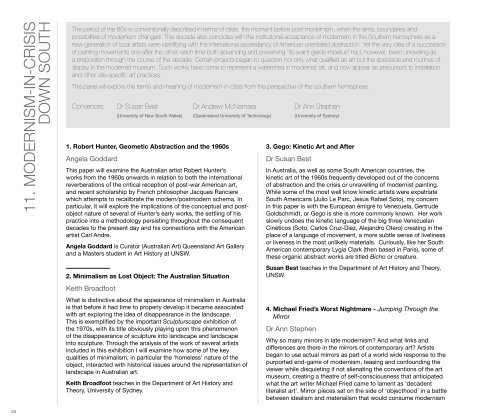2009 AAANZ Conference Abstracts - The Art Association of Australia ...
2009 AAANZ Conference Abstracts - The Art Association of Australia ...
2009 AAANZ Conference Abstracts - The Art Association of Australia ...
Create successful ePaper yourself
Turn your PDF publications into a flip-book with our unique Google optimized e-Paper software.
11. MODERNISM-IN-CRISIS<br />
DOWN SOUTH<br />
<strong>The</strong> period <strong>of</strong> the 60s is conventionally described in terms <strong>of</strong> crisis, the moment before post-modernism, when the aims, boundaries and<br />
possibilities <strong>of</strong> modernism changed. This decade also coincides with the institutional acceptance <strong>of</strong> modernism in the Southern hemisphere as a<br />
new generation <strong>of</strong> local artists were identifying with the international ascendancy <strong>of</strong> American orientated abstraction. Yet the very idea <strong>of</strong> a succession<br />
<strong>of</strong> painting movements one after the other, each time both advancing and preserving “its avant-garde impetus” had, however, been unraveling as<br />
a proposition through the course <strong>of</strong> the decade. Certain projects began to question not only what qualified as art but the spectacle and routines <strong>of</strong><br />
display in the modernist museum. Such works have come to represent a watershed in modernist art, and now appear as precursors to installation<br />
and other site-specific art practices.<br />
<strong>The</strong> panel will explore the terms and meaning <strong>of</strong> modernism-in-crisis from the perspective <strong>of</strong> the southern hemisphere.<br />
Convenors: Dr Susan Best Dr Andrew McNamara Dr Ann Stephen<br />
1. Robert Hunter, Geometic Abstraction and the 1960s<br />
Angela Goddard<br />
This paper will examine the <strong>Australia</strong>n artist Robert Hunter’s<br />
works from the 1960s onwards in relation to both the international<br />
reverberations <strong>of</strong> the critical reception <strong>of</strong> post-war American art,<br />
and recent scholarship by French philosopher Jacques Ranciere<br />
which attempts to recalibrate the modern/postmodern schema. In<br />
particular, it will explore the implications <strong>of</strong> the conceptual and postobject<br />
nature <strong>of</strong> several <strong>of</strong> Hunter’s early works, the settling <strong>of</strong> his<br />
practice into a methodology persisting throughout the consequent<br />
decades to the present day and his connections with the American<br />
artist Carl Andre.<br />
Angela Goddard is Curator (<strong>Australia</strong>n <strong>Art</strong>) Queensland <strong>Art</strong> Gallery<br />
and a Masters student in <strong>Art</strong> History at UNSW.<br />
2. Minimalism as Lost Object: <strong>The</strong> <strong>Australia</strong>n Situation<br />
Keith Broadfoot<br />
(University <strong>of</strong> New South Wales) (Queensland University <strong>of</strong> Technology) (University <strong>of</strong> Sydney)<br />
What is distinctive about the appearance <strong>of</strong> minimalism in <strong>Australia</strong><br />
is that before it had time to properly develop it became associated<br />
with art exploring the idea <strong>of</strong> disappearance in the landscape.<br />
This is exemplified by the important Sculpturscape exhibition <strong>of</strong><br />
the 1970s, with its title obviously playing upon this phenomenon<br />
<strong>of</strong> the disappearance <strong>of</strong> sculpture into landscape and landscape<br />
into sculpture. Through the analysis <strong>of</strong> the work <strong>of</strong> several artists<br />
included in this exhibition I will examine how some <strong>of</strong> the key<br />
qualities <strong>of</strong> minimalism, in particular the ‘homeless’ nature <strong>of</strong> the<br />
object, interacted with historical issues around the representation <strong>of</strong><br />
landscape in <strong>Australia</strong>n art.<br />
Keith Broadfoot teaches in the Department <strong>of</strong> <strong>Art</strong> History and<br />
<strong>The</strong>ory, University <strong>of</strong> Sydney.<br />
3. Gego: Kinetic <strong>Art</strong> and After<br />
Dr Susan Best<br />
In <strong>Australia</strong>, as well as some South American countries, the<br />
kinetic art <strong>of</strong> the 1960s frequently developed out <strong>of</strong> the concerns<br />
<strong>of</strong> abstraction and the crisis or unravelling <strong>of</strong> modernist painting.<br />
While some <strong>of</strong> the most well know kinetic artists were expatriate<br />
South Americans (Julio Le Parc, Jesús Rafael Soto), my concern<br />
in this paper is with the European émigré to Venezuela, Gertrude<br />
Goldschmidt, or Gego is she is more commonly known. Her work<br />
slowly undoes the kinetic language <strong>of</strong> the big three Venezuelan<br />
Cinéticos (Soto, Carlos Cruz-Diez, Alejandro Otero) creating in the<br />
place <strong>of</strong> a language <strong>of</strong> movement, a more subtle sense <strong>of</strong> liveliness<br />
or liveness in the most unlikely materials. Curiously, like her South<br />
American contemporary Lygia Clark (then based in Paris), some <strong>of</strong><br />
these organic abstract works are titled Bicho or creature.<br />
Susan Best teaches in the Department <strong>of</strong> <strong>Art</strong> History and <strong>The</strong>ory,<br />
UNSW.<br />
4. Michael Fried’s Worst Nightmare - Jumping Through the<br />
Mirror<br />
Dr Ann Stephen<br />
Why so many mirrors in late modernism And what links and<br />
differences are there in the mirrors <strong>of</strong> contemporary art <strong>Art</strong>ists<br />
began to use actual mirrors as part <strong>of</strong> a world wide response to the<br />
purported end-game <strong>of</strong> modernism, teasing and confounding the<br />
viewer while disquieting if not alienating the conventions <strong>of</strong> the art<br />
museum, creating a theatre <strong>of</strong> self-consciousness that anticipated<br />
what the art writer Michael Fried came to lament as ‘decadent<br />
literalist art’. Mirror pieces sat on the side <strong>of</strong> ‘objecthood’ in a battle<br />
between idealism and materialism that would consume modernism<br />
34



